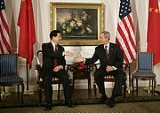
All-China Federation of Industry and Commerce
Encyclopedia

Chamber of commerce
A chamber of commerce is a form of business network, e.g., a local organization of businesses whose goal is to further the interests of businesses. Business owners in towns and cities form these local societies to advocate on behalf of the business community...
, established in 1953 as a successor to the chambers of commerce that were first founded during the Qing Dynasty
Qing Dynasty
The Qing Dynasty was the last dynasty of China, ruling from 1644 to 1912 with a brief, abortive restoration in 1917. It was preceded by the Ming Dynasty and followed by the Republic of China....
. Today, it consists of Chinese industrialists and business people under the leadership of the United Front Department
United Front (PRC)
The United Front in the People's Republic of China is a nominally popular front led by the Communist Party of China. It is managed by the United Front Work Department of the Central Committee of the Communist Party of China and besides the communist party it consists of eight minor parties and the...
of the Communist Party of China
Communist Party of China
The Communist Party of China , also known as the Chinese Communist Party , is the founding and ruling political party of the People's Republic of China...
, as well as being a constituent organization of the National Committee of the Chinese People’s Political Consultative Conference and the holder of a number of seats in the National People's Congress
National People's Congress
The National People's Congress , abbreviated NPC , is the highest state body and the only legislative house in the People's Republic of China. The National People's Congress is held in the Great Hall of the People, Beijing, capital of the People's Republic of China; with 2,987 members, it is the...
. The organization assists the government in managing China's private economy and acts as a bridge between the private sector and the government.
Core functions
The core responsibilities of the ACFIC are to:- Increase communications between the government and the private economy;
- Assist the government in managing the private economy;
- Participate in political consultation of national policies and strategies in politics, economy and social affairs;
- Help its members in technological innovation, management and culture for increased competitiveness and in achieving sustainable development;
- Represent the legitimate rights of its members and to extend their proposals and requirements to government;
- Provide members with services in training, financing, technology, legal consultation and information, and to resolve the difficulties and problems they are facing;
- Build closer relationships with foreign commercial and industrial entities;
- Help members to go overseas for business opportunities and contribute to China’s economic reforms.
Structure
The agency is structured into the following departments:- General Office
- Department of Research
- Department of Membership
- Department of Publicity and Education
- Department of Economic Service
- Department of Poverty Relief and Social Service
- Department of International Liaison
- Department of Legal Affairs
- Department of Human Resources
Leadership
Since November 2002, the ACFIC has been led by Chairman Huang MengfuHuang Mengfu
Huang Mengfu is a vice chairman of the China People's Political Consultative Conference and chairman of the All-China Federation of Industry and Commerce. He ranks as a national leader of China....
, who, like his predecessors, is also a vice chairman of the CPPCC National Committee, ranking as a national leader of China
Political position ranking of the People's Republic of China
The political ranking of the People's Republic of China is the ranking of political leaders in China, by order of presumed political power. Although there is no formally published ranking, there is usually an established convention and protocol, and the relative positions of Chinese political...
. His predecessor was Jing Shuping
Jing Shuping
Jing Shuping was a Chinese businessman who founded the Minsheng Bank, the first privately owned bank to open in the Communist People's Republic of China, in 1996.Jing Shuping graduated from the former Saint John's University in Shanghai in 1939...
, founder of the first private bank in modern China and the son of a well-known entrepreneur of the later Qing Dynasty.
First vice-chairman of the ACFIC is Quan Zhezhu , a deputy minister of the United Front Department of the CPC Central Committee originally from Jilin
Jilin
Jilin , is a province of the People's Republic of China located in the northeastern part of the country. Jilin borders North Korea and Russia to the east, Heilongjiang to the north, Liaoning to the south, and Inner Mongolia to the west...
. ACFIC has another 23 vice-chairpersons, most of them private entrepreneurs.
Regional federations
More than 3,000 regional federations of industry and commerce (FIC) have been established in all provinces and prefectures and most counties of China. As of 2009, they listed a combined membership of 2.6 million private enterprises. The relationship between ACFIC and the regional FIC is described as a role of guidance, but the statute of ACFIC is also valid for the regional federations.See also
- Industrial history of the People's Republic of ChinaIndustrial history of the People's Republic of ChinaThe technological and industrial history of the People's Republic of China is a long one. China's industrial sector has shown great progress since 1949, but in the late 1980s it remained undeveloped in many respects...
- Ministry of Commerce of the People's Republic of ChinaMinistry of Commerce of the People's Republic of ChinaThe Ministry of Commerce of the People's Republic of China , formerly Ministry of Foreign Trade and Economic Co-operation is an executive agency of the State Council of China...

